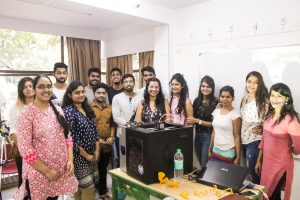
The atmosphere at Cindrebay School of Fashion and Interior Design, came alive last week when they got “Julia” in the campus. No, ‘Julia’ isn’t a new student, it’s the name of the 3D printer they arranged for a design and printing workshop.
For an entire week starting from 14th August to 20th August, THE VOID, an initiative by Cindrebay, came up with an idea to host a workshop to explore the possibilities the 3D printing technology had to offer. Entirely for the benefit of the students, the institute organized the workshop which went on to give them a broader idea of the new advancements being made in the field of design and the various applications it may be useful for.

In Ar. Khushboo Agrawal’s words, “This is a one of a kind seminar being held by THE VOID. We like to introduce a lot of new concepts to our students, make them updated with the latest modern techniques, softwares and resources. A lot of advancements are being made in the design field everyday. At Cindrebay, we strive to incorporate new methods of educating our students and keep them abreast about latest design and market trends, so that they can enter the market later with confidence and all round knowledge.”
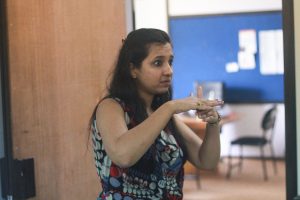
On day 1, the goal was to familiarize the students with how the machine works, what are the principles behind the technology, the expertise required to use it and the various do’s and don’ts to be followed in order to achieve a great final output. The students listened intently as the representative from “Teslabs”, the manufacturing company of the 3D printer, in Nagpur, explained the entire process and gave them tips on how it can be optimized and thus used to it’s full potential.
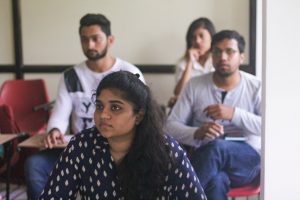
Students were also instructed, to prepare a 3D model, or chose one online to get it printed in the following week. They were told to carefully analyze the object, cut multiple sections of it on a software of their choice (most used Sketchup) and verify whether the model was of printable quality and desired dimensions. Focus was to be given on scaled models of chairs, lamps, décor items in order to hone their skills in furniture and product design. A lot of students showed immense enthusiasm and came up with various ideas and novel designs for accent seats, pendant lights, pen stands, wall hangings etc.
The following 3 days were spent in printing the various models the students had developed and curated online. They were taught to use the software, “Fracktory”, which is compatible with the 3D printer and helps one to visualize and slice the 3D model. They were also instructed to estimate the printing time, with the help of the software and minimize wastage while printing. The students learnt how different filaments could be used to make different types of articles, how to change settings to optimize the output, how to use various colors to print a single item and how to decrease printing time using correct settings and orienting the model accordingly.

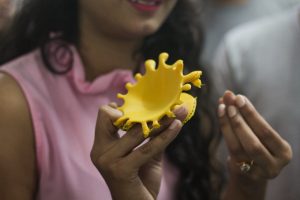
The models which were printed by Day 5, were further scrutinized and studied by the students in minute detail. This exercise helped them to identify the faults and flaws in their design and how to overcome them. The students then corrected the shortcomings of their models on software. With the help of tangible solid prints, they were able to understand the modifications needed to make it more stable and functional. It, thus, improved their understanding of furniture and instilled in their minds the governing principles of furniture and product design.
On day 6, notable artists in the city spoke to the students about exploiting latest devices and gadgets to better their design. Ar. Stuti Vij addressed the students and said, “A design is never complete. You can always improve it. By constantly studying and reimagining your work, you can arrive at your best result.” Ar. Jamila Sidhpurwala also conducted a small experiment and asked the students to exchange their models with each other. They were then told to list 3 positives and 3 negatives in their partner’s model. According to her, a fresh pair of eyes always helps a designer. Sometimes, something which is so obvious to someone else, doesn’t strike us at all. We become much too involved with our design to look at it from a fresh perspective. Hence, asking someone’s opinion and re-evaluating our work, always give excellent results.
Soon, the last and final day of the workshop arrived. An open forum was organized on Sunday, 20th August, for public and students from other institutes and fields. The response was huge and many people turned up with a lot of curiosity about the machine. A Teslabs representative gave a short presentation explaining the various types of “Stereolithography” methods, the various parts of the machine, the way they work and it’s applications. The guests were also given an opportunity to print models of their choice. A lot of them printed action figures, mobile covers, footwear and small lamps.
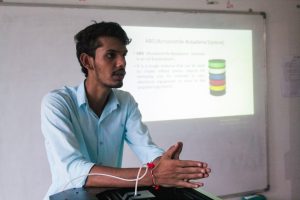
To sum it up, the seven-day workshop gave the students great insight into the future of design. It also taught them to introspect their work and improve it using latest methods and technology. All credit goes to ‘THE VOID’ for organizing such a wonderful week and employing new teaching practices. For more such informative workshops and seminars, please drop by Cindrebay School of Fashion and Interior Design, Nagpur.
